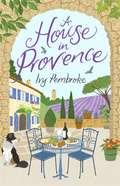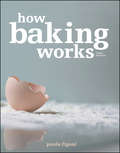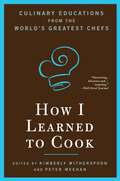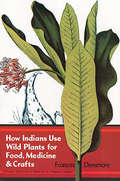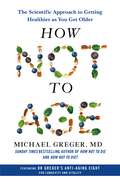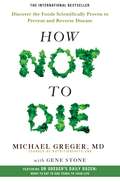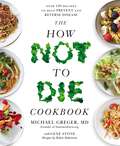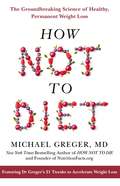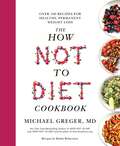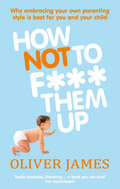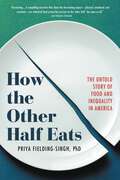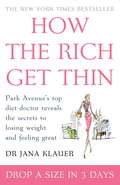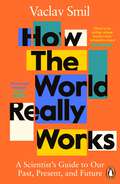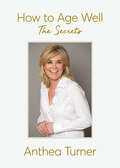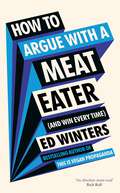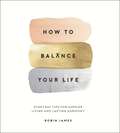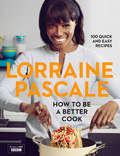- Table View
- List View
House & Garden A Year in the Kitchen: Seasonal recipes for everyday pleasure
by Blanche Vaughan'The elegant simplicity and style of every word and picture in this book are a joy.' JEREMY LEE'An engaging and inspiring book of food that is a real pleasure.' CLAUDIA RODEN'I love the flavour-dense simplicity of Blanche's recipes, with the garden at their heart. This is exactly how I want to eat.' SARAH RAVEN'Blanche Vaughan combines easy-to-achieve recipes with an inspiring voice that encourages experiment, whether you are cooking a simple supper for two or a special occasion feast. Her calm and reflective attitude to cooking is mirrored in the beautiful photographs, while her emphasis on seasonality truly makes it a book for all seasons.' ALEXANDRA SHULMAN'These are the recipes I cook at home, dishes that I turn to throughout the year because they answer a craving for a particular thing to eat at a particular time. The recipes evolved from ideas for what to cook and what I chose to include in the food pages of House & Garden each month: a reflection of our appetites, the food growing then, the weather, how we are living and eating each season.'BLANCHE VAUGHANA Year in the Kitchen, written and curated by Blanche Vaughan, Food Editor of House & Garden, shares more than 150 deliciously easy recipes inspired by the seasons. Recipes include:- Asparagus Carbonara (Spring)- Summer Greens & Soft-Cheese Pie (Summer)- Pumpkin Soup with Gruyère and Sage (Autumn)- Claudia Roden's Chicken with Sweet Wine and Grapes (Winter)
A House in Provence
by Ivy PembrokeIt's the offer of a lifetime - a whole summer in a farmhouse in the sun-drenched French countryside! But Libby might have bitten off more than she can chew . . .As Libby, her new husband Sam, his son Teddy, and their helpful dog Jack explore the rambling, enchanting house, meet the locals and learn some delicious French cooking, they are joined by friends from home who are as affected by the breathtaking countryside as they are.When Libby's friend Isla, who has been restlessly travelling for years, comes to stay, she meets and falls for American Brooke, who works at the local vineyard. Will Brooke be the one to finally get Isla to stay in one place?And then Libby has a surprise for Sam . . .One summer in Provence will change all their lives for ever.
How and When to Be Your Own Doctor
by Isabelle A. Moser Steve SolomonDr. Isabelle A. Moser and Steve Solomon collaborated on How and When to Be Your Own Doctor. When Solomon reached his late thirties, he began looking for healthy alternatives. He met Moser and began the practice of a yearly fast to cleanse his body. This book contains their combined knowledge on healing. Topics include How I Became a Hygienist, The Nature and Cause of Disease, Fasting, Colon Cleansing, Diet and Nutrition, Vitamins and Other Food Supplements and The Analysis of Disease States--Helping the Body Recover.
How Baking Works: Exploring the Fundamentals of Baking Science
by Paula I. FigoniAn up-to-date, comprehensive guide to understanding and applying food science to the bakeshop. The essence of baking is chemistry, and anyone who wants to be a master pastry chef must understand the principles and science that make baking work. This book explains the whys and hows of every chemical reaction, essential ingredient, and technique, revealing the complex mysteries of bread loaves, pastries, and everything in between. Among other additions, How Baking Works, Third Edition includes an all-new chapter on baking for health and wellness, with detailed information on using whole grains, allergy-free baking, and reducing salt, sugar, and fat in a variety of baked goods. This detailed and informative guide features: An introduction to the major ingredient groups, including sweeteners, fats, milk, and leavening agents, and how each affects finished baked goods Practical exercises and experiments that vividly illustrate how different ingredients function Photographs and illustrations that show the science of baking at work End-of-chapter discussion and review questions that reinforce key concepts and test learning For both practicing and future bakers and pastry chefs, How Baking Works, Third Edition offers an unrivaled hands-on learning experience.
How Baking Works: …And what to do if it doesn’t
by James MortonI want to show you how baking works. I want to prove how easy baking can be. Whether you want light cakes, squidgy brownies, perfect pastry, stress-free macarons or mountainous meringues, this book features a mini-masterclass for each one.Everything's split up into wee, simple steps. There's no faff and you don't need any expensive equipment. You don't even need a sieve.And for baking veterans, this book tells you why you're doing what you've been doing all these years.Here’s to baking that just works.
How Carrots Won the Trojan War: Curious (but True) Stories of Common Vegetables
by Rebecca RuppUnearth incredible tales of how well-known vegetables have made their way from the dinner plate to the annals of human experience.
How Fermented Foods Feed a Healthy Gut Microbiota: A Nutrition Continuum
by M. Andrea Azcarate-Peril Roland R. Arnold José M. Bruno-BárcenaThis book examines the role of fermented foods on human gut health and offers a unique contribution to this rapidly growing area of study. Fermented foods have been consumed by humans for millennia. This method of food preservation provided early humans with beneficial bacteria that re-populated the gut microbiota upon consumption. However, novel methods of production and conservation of food have led to severed ties between the food that modern humans consume and the gut microbiota. As a consequence, there has been a documented increase in the prevalence of autoimmune diseases and obesity, which has been correlated to decreased diversity of gut microbes, while infectious disorders have decreased in the three past decades.With the intention of providing a thorough overview of the relationship between fermented foods, nutrition, and health, the editors have grouped the chapters into three thematic sections: food and their associated microbes, the oral microbiome, and the gut microbiome. After an introduction dedicated to the environmental microbiome, Part I provides an overview of what is currently known about the microbes associated with different foods, and compares traditional forms of food preparation with current industrial techniques in terms of the potential loss of microbial diversity. The chapters in Part 2 explore the oral microbiota as a microbial gatekeeper and main contributor to the gut microbiota. Part 3 introduces beneficial modulators of the gut microbiome starting with the establishment of a healthy gut microbiota during infancy, and continuing with the role of probiotics and prebiotics in health preservation and the imbalances of the gut microbiota. In the final section the editors offer concluding remarks and provide a view of the future brought by the microbiome research revolution.This study is unique in its emphasis on the convergence of two very relevant fields of research: the field of studies on Lactic Acid Bacteria (LAB) and fermented foods, and microbiome research. The relationship between these fields, as presented by the research in this volume, demonstrates the intimate connection between fermented foods, the oral and gut microbiota, and human health. Although research has been done on the impact of diet on the gut microbiome there are no publications addressing the restorative role of food as microbe provider to the gut microbiota. This novel approach makes the edited volume a key resource for scientific researchers working in this field.
How I Learned To Cook: Culinary Educations from the World's Greatest Chefs
by Peter Meehan Kimberly WitherspoonBefore he was a top chef, Tom Colicchio learned to love cooking when he was still slinging burgers at a poolside snack bar. Barbara Lynch tells the story of lying her way into her first chef's job and then needing to cook her way out of trouble in the galley kitchen of a ship at sea. Stories of mentorship abound: Rick Bayless tells the story of finally working with Julia Child, his childhood hero; Gary Danko of earning the trust of the legendary Madeleine Kamman. How I Learned to Cook is an irresistible treat, a must-have for anyone who loves food and wants a look into the lives of the men and women who masterfully prepare it.
How Indians Use Wild Plants for Food, Medicine & Crafts
by Frances Densmore"Learn the natural ways of the Chippewa Indians with this great book from Dover." — Texas Kitchen and Garden and MoreThe uses of plants — for food, for medicine, for arts, crafts, and dyeing — among the Chippewa Indians of Minnesota and Wisconsin show the great extent to which they understood and utilized natural resources. In this book those traditions are captured, providing a wealth of new material for those interested in natural food, natural cures, and native crafts.In separate sections describing the major areas of use, Miss Densmore, an ethnologist with the Smithsonian Institution, details the uses of nearly 200 plants with emphasis on wild plants and lesser-known uses. For those interested in natural foods she gives extensive coverage to the gathering and preparation of maple sugar and wild rice, as well as preparations for beverages from leaves and twigs of common plants, seasonings including mint and bearberry, the methods of preparing wild rice and corn, cultivated and wild vegetables, and wild fruits and berries. On Indian medicines she tells the basic methods of gathering plants and the basic surgical and medical methods. Then she gives a complete list of the plants with their botanical names, uses, parts used, preparation and administration, and other notes and references. Also covered are plants used as charms, plants used in natural dyes, and plants in the useful and decorative arts including uses for household items, toys, mats, twine, baskets, bows, and tools, with special emphasis on the uses of birch bark and cedar. This section will be especially useful for supplying new and unusual craft ideas. In addition, 36 plates show the many stages of plant gathering and preparation and many of the artistic uses. While a number of the plants discussed are native only to the Great Lakes region, many are found throughout a wide range.Those studying the Indians of the Great Lakes region, or those trying to get back to nature through understanding and using natural materials, will find much about the use of plants in all areas of community life. Because of Miss Densmore’s deep knowledge and clear presentation, her study remains a rich and useful source for learning about or using native foods, native cures, and native crafts.
How Not to Age: The Scientific Approach to Getting Healthier as You Get Older
by Michael GregerTHE SUNDAY TIMES BESTSELLERAs featured on the trending Netflix show You Are What You Eat.Live better for longer with this ultimate guide to longevity from the bestselling author of How Not to Die.We all want to stay healthy as we age but, with so many different claims out there, it can be hard to know the best advice to follow. In How Not to Age, Dr Michael Greger digs into the top peer-reviewed anti-ageing research to deliver a complete and optimal guide with simple steps to extend your lifespan and slow the adverse effects of ageing.Inspired by the dietary and lifestyle patterns of the world’s centenarians and residents of ‘blue zone’ regions where people live the longest, Dr Greger presents easy, evidence-based ways to preserve the body functions that keep us feeling youthful, both physically and mentally. Can an apple a day really keep the doctor away? What’s better for your longevity, jogging for four hours or eating two handfuls of nuts twice a week?Brimming with expertise, How Not to Age lays out practical strategies for living your longest, healthiest life – and for enjoying every moment of it.
How Not To Die: Discover the foods scientifically proven to prevent and reverse disease
by Gene Stone Dr Michael GregerThe International Bestseller'Dr Michael Greger reveals the foods that will help you live longer' Daily Mail'This book may help those who are susceptible to illnesses that can be prevented with proper nutrition' His Holiness the Dalai LamaWhy rely on drugs and surgery to cure you of life-threatening disease when the right decisions can prevent you from falling ill to begin with?How Not To Die gives effective, scientifically-proven nutritional advice to prevent our biggest killers - including heart disease, breast cancer, prostate cancer, high blood pressure and diabetes - and reveals the astounding health benefits that simple dietary choices can provide. Based on the latest scientific research, the internationally bestselling How Not To Die examines each of the most common diseases to reveal what, how and why different foods affect us, and how increasing our consumption of certain foods and avoiding others can dramatically reduce our risk of falling sick and even reverse the effects of disease. It also shares Dr Greger's 'Daily Dozen' - the twelve foods we should all eat every day to stay in the best of health.With emphasis on individual family health history and acknowledging that everyone needs something different, Dr Michael Greger offers practical dietary advice to help you live longer, healthier lives.
The How Not To Die Cookbook: Over 100 Recipes to Help Prevent and Reverse Disease
by Dr Michael GregerFrom the author of the global bestseller How Not To Die comes The How Not To Die Cookbook – a lavish, beautifully illustrated collection of delicious recipes based on the groundbreaking nutritional science of the original book. Dr Michael Greger, founder of the wildly popular website NutritionFacts, takes his comprehensive, lifesaving science into the kitchen. Why suffer from disease and ill health when the right food is proven to keep you healthy, and without the side effects of drugs? We can avoid heart disease, cancer and our other biggest killers if we use food as medicine, and the How Not To Die Cookbook offers a sustainable and delicious guide to preparing and eating the foods that will prevent and reverse fatal diseases.Featuring over 100 easy-to-follow, beautifully photographed plant-based recipes, with plenty of recipes suitable for vegetarians and vegans, the How Not To Die Cookbook merges cutting-edge science with everyday ingredients from the supermarket to help you and your family eat your way to better health and a longer life.
How Not To Diet: The Groundbreaking Science of Healthy, Permanent Weight Loss
by Michael GregerPut an end to dieting and replace weight-loss struggles with this easy approach to a healthy, plant-based lifestyle, from the bestselling author of How Not to Die.Every month seems to bring a trendy new diet or a new fad to try in order to lose weight – but these diets aren’t making us any happier or healthier. As obesity rates and associated disease and impairments continue to rise, it’s time for a different approach.How Not to Diet is a treasure trove of buried data and cutting-edge dietary research that Dr Michael Greger has translated into accessible, actionable advice with exciting tools and tricks that will help you to safely lose weight and eliminate unwanted body fat – for good.Dr Greger, renowned nutrition expert, physician, and founder of nutritionfacts.org, explores the many causes of obesity – from our genes to the portions on our plate to other environmental factors – and the many consequences, from diabetes to cancer to mental health issues. From there, Dr Greger breaks down a variety of approaches to weight loss, honing in on the optimal criteria that enable success, including: a diet high in fibre and water, a diet low in fat, salt, and sugar, and diet full of anti-inflammatory foods.How Not to Diet then goes beyond food to explore the many other weight-loss accelerators available to us in our body’s systems, revealing how plant-based meals can be eaten at specific times to maximize our bodies’ natural fat-burning activities. Dr Greger provides a clear plan not only for the ultimate weight loss diet, but also the approach we must take to unlock its greatest efficacy.
The How Not To Diet Cookbook: Over 100 Recipes for Healthy, Permanent Weight Loss
by Michael GregerFrom Michael Greger, M.D., the author of the New York Times bestseller How Not to Die, comes a full-color, fully illustrated cookbook that shares the science of long-term weight-loss success.Greger offers readers delicious yet healthy options that allow them to ditch the idea of 'dieting' altogether. As outlined in his book How Not to Diet, Greger believes that identifying the twenty-one weight-loss accelerators in our bodies and incorporating new, cutting-edge medical discoveries are integral in putting an end to the all-consuming activity of counting calories and getting involved in expensive juice cleanses and Weight Watchers schemes.The How Not to Diet Cookbook is a revolutionary addition to the cookbook industry: incredibly effective and designed for everyone looking to make changes to their dietary habits to improve their quality of life.
How Not to Eat Ultra-Processed: Your 4-week plan for life-changing healthier eating habits
by Nichola Ludlam-RaineWe know we should eat fewer ultra-processed foods; this book shows you how to do it.From expert dietitian, Nichola Ludlam-Raine, comes this simple, easy-to-follow plan for reducing the ultra-processed foods in your diet.Taking you through 4 weeks, each focused on a different meal (snacks and drinks, breakfast, lunch and dinner), Nichola equips you with the practical ways you can make a huge difference to your diet through small, achievable changes.Along the way she also debunks the myths that surround ultra-processed foods and provides answers to the most commonly asked questions, to help soothe anxiety around what you eat and enable you to feel confident with what's on your plate, wherever you are and whatever time of the day.With recipes to get you started and a comprehensive list of over 100 processed and ultra-processed foods, ranked according to their nutritional benefits and with guidance on how often you should eat them, this is a necessary guide for anyone looking to eat healthier and make a real change to their long-term health.
How Not to F*** Them Up
by Oliver JamesAs a mother, are you comfortable in your skin?Want to know how best to be a stay-at-home or working mum?Babies have very simple needs, yet many parents are overwhelmed with elaborate advice on how to meet them. In How Not to F*** Them Up, leading child psychologist Oliver James argues that your under-threes do not need training; it's getting your head straight as a parent that's important.Drawing on extensive interviews and the lastest clinical research, James identifies three basic types of mum: the Hugger, the Organiser and the Fleximum. Outlining the benefits and pitfalls of each, How Not to F*** Them Up shows you how to recognise which style suits you best and outlines simple strategies to reconcile personal ambitions with the needs of your family.Empowering and provocative, Oliver James will help you make the best choices for bringing up a happy, confident child.
How the Other Half Eats: The Untold Story of Food and Inequality in America
by Priya Fielding-SinghA &“deeply empathetic&” (Publishers Weekly, starred review) and &“eye-opening&” (Kirkus Review ) look at dietary differences along class lines, revealing that lack of access to healthy food is far from the primary driver of nutritional inequality in America. Inequality in America manifests in many ways, but perhaps nowhere more than in how we eat. From her years of field research, sociologist and ethnographer Priya Fielding-Singh brings us into the kitchens of dozens of families from varied educational, economic, and ethnoracial backgrounds to explore how—and why—we eat the way we do. We get to know four families intimately: the Bakers, a Black family living below the federal poverty line; the Williamses, a working-class white family just above it; the Ortegas, a middle-class Latinx family; and the Cains, an affluent white family.Whether it's worrying about how far pantry provisions can stretch or whether there's enough time to get dinner on the table before soccer practice, all families have unique experiences that reveal their particular dietary constraints and challenges. By diving into the nuances of these families&’ lives, Fielding-Singh lays bare the limits of efforts narrowly focused on improving families&’ food access. Instead, she reveals how being rich or poor in America impacts something even more fundamental than the food families can afford: these experiences impact the very meaning of food itself.Packed with lyrical storytelling and groundbreaking research, as well as Fielding-Singh&’s personal experiences with food as a biracial, South Asian American woman, How the Other Half Eats illuminates exactly how inequality starts on the dinner plate. Once you&’ve taken a seat at tables across America, you&’ll never think about class, food, and public health the same way again.
How the Rich Get Thin: Park Avenue's Top Diet Doctor Reveals The Secrets To Losing Weight And Feeling Great
by Dr Jana KlauerNew York's top weight-control doctor finally reveals the secrets to the enviably lean bodies leaving her Park Avenue offices. Based on science and proved by the success of client after client, Dr Jana Klauer's diet is the key to how successful, rich and busy modern men and women get weight off and keep it off. How the Rich Get Thin features wonderful recipes, including the low-cal desert Le Socia-Lite. Begin with Dr Klauer's Non-negotiables - including 'Say yes to complex carbohydrates' and 'Get lots of calcium from dairy products' - and add a simple mind-set change to control those cravings, and watch yourself lose that weight!
How the World Really Works: A Scientist’s Guide to Our Past, Present and Future
by Vaclav Smil* THE NEW YORK TIMES BESTSELLER * 'Another masterpiece from one of my favorite authors . . . If you want a brief but thorough education in numeric thinking about many of the fundamental forces that shape human life, this is the book to read. It's a tour de force' BILL GATES __________ We have never had so much information at our fingertips and yet most of us don't know how the world really works. This book explains seven of the most fundamental realities governing our survival and prosperity. From energy and food production, through our material world and its globalization, to risks, our environment and its future, How the World Really Works offers a much-needed reality check - because before we can tackle problems effectively, we must understand the facts. In this ambitious and thought-provoking book we see, for example, that globalization isn't inevitable and that our societies have been steadily increasing their dependence on fossil fuels, making their complete and rapid elimination unlikely. Drawing on the latest science and tackling sources of misinformation head on - from Yuval Noah Harari to Noam Chomsky - ultimately Smil answers the most profound question of our age: are we irrevocably doomed or is a brighter utopia ahead? __________ 'Very informative and eye-opening in many ways' HA-JOON CHANG, author of 23 Things They Don't Tell You About Capitalism 'If you are anxious about the future, and infuriated that we aren't doing enough about it, please read this book' PAUL COLLIER, author of The Future of Capitalism
How to Age Well: The Secrets
by Anthea TurnerHow to Age Well is a carefully researched, beautifully presented guide to ageing with style and grace. The author who is renowned for her own glamorous look, has spoken to and worked with literally dozens of beauty and fitness experts over the decades. Here she reveals their secrets, hacks and tips on how to always look one’s best, from achieving amazing skin, dealing with weight gain and the menopause, to spiritual well-being and contentment. This is a must-have companion, for every woman wanting to look and feel her best, packed full of stunning photographs and expertise from some of the top names in the beauty, fitness and wellness industries.
How to Argue With a Meat Eater (And Win Every Time)
by Ed WintersAn empowering and deeply informative book – MobyChallenge their beliefs; change the worldIf you are a vegan, you’ll know all too well how provocative it can be – you never know when you’ll be challenged or how. But being able to face down and rebut arguments against veganism is hugely important. Not just because many of the arguments lack substance, but because every interaction provides a pivotal moment to create change.How to Argue With a Meat Eater will teach you to not only become a skilled debater, sharing the secrets of renowned vegan educator Ed Winters, but it will arm you with powerful facts and insights that will give pause to even the most devout meat eater.Providing you with the knowledge to become a better conversationalist and critical thinker, and the motivation to create a more ethical, kind and sustainable world, let this book be your guide and inspiration to know that, no matter what the argument, you can win every time.
How to Bake: How To Bake - The Perfect Victoria Sponge And Other Baking Secrets (The\great British Bake Off Ser.)
by Paul HollywoodAt last, the star of BBC2's The Great British Bake Off reveals all the secrets of his craft in How to Bake. The son of a baker, Paul Hollywood is passionate about busting the myths that surround baking, sharing his finely honed skills, and showing that with the right guidance, anybody can achieve success time after time. With this in mind, he has filled this book with easy-to-follow, clearly explained, utterly delicious recipes. Having taken you through the basic techniques, Paul explains how to make an abundance of breads, pastries, cakes and biscuits including wholemeal loaf, tin bread, ciabatta, focaccia, sour cherry and chocolate loaf, Roquefort and almond bread, fresh croissants, milles feuilles, quiche, classic Victoria sponge, lemon drizzle cake, chocolate temptation cake, buttery shortbread and fiery ginger biscuits. Time to get baking ...
How to Balance Your Life: Everyday Tips for Simpler Living and Lasting Harmony
by Robin JamesAchieving a sense of equilibrium and inner peace can prove elusive when so many demands and responsibilities are constantly vying for your attention. Discover the tools for finding harmony in all aspects of your life with practical tips on everything from managing everyday stress to finding a work/life balance that is right for you. This inspirational book will help you find ways to maintain a healthy diet and lifestyle and be more mindful of the wider world and your impact upon it, while making sure there is always room for ‘me’ time.Balancing your life is essential to your health and well-being, and by applying a few simple concepts you will live your life at a pace that is comfortable and ultimately rewarding.
How to Be a Better Cook
by Lorraine PascaleTV chef Lorraine Pascale’s fabulous new prime-time BBC Two TV tie-in “How to be a Better Cook”
How to Be a Better Cook
by Lorraine PascaleTV chef Lorraine Pascale’s fabulous new prime-time BBC Two TV tie-in “How to be a Better Cook”

